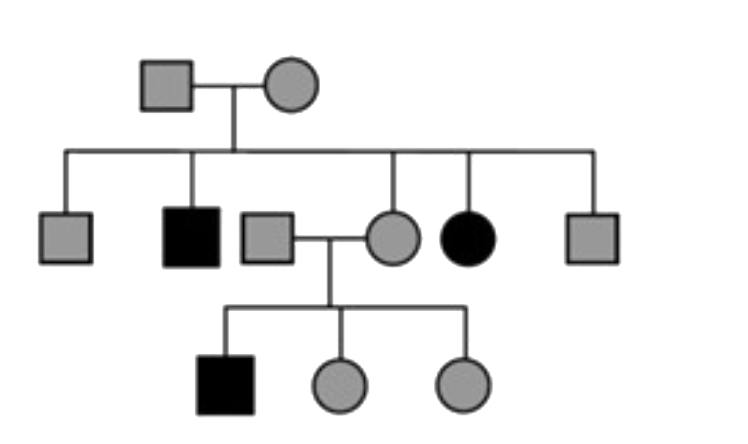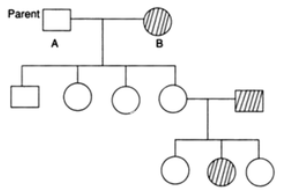If both parents are carriers for thalessemia, which is ai:, autosomal recessive disorder, what are the chan~e~ pregnancy resulting in an affected child?
0.25
1
no chance
0.5
The correct Answer is:1
To solve the problem regarding the chances of having a child affected by thalassemia when both parents are carriers, we can follow these steps:
1. Understand the Genetic Condition:
- Thalassemia is an autosomal recessive disorder. This means that a child must inherit two copies of the thalassemia gene (one from each parent) to express the disease.
2. Identify the Genotypes of the Parents:
- Since both parents are carriers, their genotypes can be represented as Tt, where 'T' is the normal allele and 't' is the thalassemia allele.
3. Set Up a Punnett Square:
- Create a Punnett square to visualize the genetic combinations that can arise from the cross between the two parents (Tt x Tt).
Tt−−−−−−−−−−−−−−−−−T|⊤|Tt|−−−−−−−−−−−−−−−−−t|Tt∣∣−−−−−−−−−−−−−−−−−
4. Analyze the Offspring Genotypes:
- From the Punnett square, we can see the possible genotypes of the offspring:
- TT (normal) - 1 out of 4
- Tt (carrier) - 2 out of 4
- tt (affected by thalassemia) - 1 out of 4
5. Calculate the Probability of an Affected Child:
- The probability of having a child affected by thalassemia (tt) is 1 out of 4, or 25%.
6. Conclusion:
- Therefore, the chances of a pregnancy resulting in an affected child (with thalassemia) when both parents are carriers is 25%.
- Thalassemia is an autosomal recessive disorder. This means that a child must inherit two copies of the thalassemia gene (one from each parent) to express the disease.
- Since both parents are carriers, their genotypes can be represented as Tt, where 'T' is the normal allele and 't' is the thalassemia allele.
- Create a Punnett square to visualize the genetic combinations that can arise from the cross between the two parents (Tt x Tt).
- From the Punnett square, we can see the possible genotypes of the offspring:
- TT (normal) - 1 out of 4
- Tt (carrier) - 2 out of 4
- tt (affected by thalassemia) - 1 out of 4
- The probability of having a child affected by thalassemia (tt) is 1 out of 4, or 25%.
- Therefore, the chances of a pregnancy resulting in an affected child (with thalassemia) when both parents are carriers is 25%.
Topper's Solved these Questions
Similar Questions
If both parents are carriers for thalessemia, which is an autosomal recessive disorder, what are the chances for pregnancy resulting in an affected child?
View SolutionIf both the parents are carriers for thalassemia which is an autosomal recessive disorder what are the chances of pregnancy resulting in an affected child
View SolutionIf both parents are carriers for thalassemia, which is an autosomal recessive disorder, what are the chances of pregnant women resulting in an affected child?
View SolutionIf both the parents are carriers of autosomal r recessive disorder thalassemia , what are the chances of pregnancy resulting in an affected child
View SolutionWhich one of the following is an example of an autosomal recessive disorder?
View SolutionIf a mother and father both have one mutant gene for a disease with an autosomal dominant inheritance, what is their risk of having an affected child?
View SolutionGiven pedigree belongs to autosomal recessive disorder , which of the following represents parental genotypes correctly ?

View SolutionGiven pedigree shows inheritance of autosomal recessive gene. What is the genotype of given parents ?

View SolutionA husband and wife have normal vision, although both of their fathers are red - green colour blind , which is inherited as an x - linked recessive trait .
What is the probability that their first child will be ?
i. A normal son
ii. A carrier daughter
iii. A colour - blind son
iv. A colour - blind daughter
View SolutionA husband and wife have normal vision, although both of their
fathers are red - green colour blind , which is inherited as an
x - linked recessive trait .
What is the probability that their first child will be ?
i. A normal son
ii. A carrier daughter
iii. A colour - blind son
iv. A colour - blind daughter
View Solution
